Arte a Peccioli, 1996
The first time that Umberto Cavenago found himself designing a work commissioned by the Municipality of Peccioli dates back to 1996, the year in which, as part of the initiative entitled “Arte a Peccioli”, he created the permanent work Rilievi in the hamlet of Montecchio. The work consists of a series of octagonal bronze elements, placed on the footsteps of the main road of the village and in precise positions obtained from the survey carried out by a team of geologists and geobiologists. Hired by the artist to carry out the study of the terrain, the technicians were tasked with detecting the "Hartmann's net": a system of lines that form a square mesh grid with its points of intersection, called "radiant nodes". As in Feng Shui, ancient geomantic art, geobiolobia also provides the basis for reorganizing the orientations of objects within one's domestic space.
Antonella Soldaini, 2020
The Hartmann net
The relief of the “Hartmann’s net” gave Cavenago the possibility of locating the radiant nodes along the road of the village in order to mark them with the bronze signs embedded in the floor which, thanks to their installation points, have indicated to the inhabitants of the houses, located along via della chiesa di Montecchio, the possible continuation of Hartmann’s net up to the inside of the houses. The knowledge of the orthogonal design of the mesh thanks to the relief made on the road has thus become a suggestion for a possible repositioning, within one’s home, of the furnishings in the different rooms, such as the orientation of one’s bed. The operational strategy adopted by Cavenago in Montecchio aimed to reduce the visibility of the artistic gesture to the minimum in favour of highlighting something already existing and already designed.
Antonella Soldaini, 2020
Sono gli anni in cui l'artista si misura con il concetto di monumento di cui, tramite le sue installazioni, mira a scardinarne gli assiomi e a mettere in evidenza l'obsolescenza e l'inadeguatezza della sua accezione: Leon (1996) ) e il più recente Leopoldo (2019) sono opere che vanno a toccare, in maniera ironica e sottile, i valori, come quelli del patriottismo e dell'eroismo, da sempre associati al concetto di celebrazione nell'opera pubblica. Alla evidente staticità e inamovibilità del monumento su piedistallo Cavenago contrapponeva la suggestione dello spostamento decelebrativo.
Antonella Soldaini, 2020
Il lavoro di Umberto Cavenago (che ha rappresentato l'Italia alla Biennale di San Paolo nel 1996) a Montecchio può passare all'occhio distratto del tutto inosservato. Inutilmente cercherete forme monumentali, architetture evidenti od ostentate epifanie di questa presenza che, invece, è riuscita a inserirsi nel contesto urbano in maniera sottile, quasi cerebrale. Il lavoro è, in effetti, ovunque, ma pressoché invisibile. Il selciato lastricato di Montecchio è costellato di formelle ottagonali in bronzo. La loro disposizione non è casuale, bensì risponde a uno schema determinato. Tale schema forma una griglia, una rete nei cui punti di intersezione sono collocati i Rilievi. Si visualizza così una sorta di campo magnetico, un reticolo invisibile a maglie larghe che imprigiona una silenziosa carica di energia. In quei punti nodali la cittadina accumula le sue forze. La linfa delle storie e dei gesti quotidiani...
Lorenzo Fusi
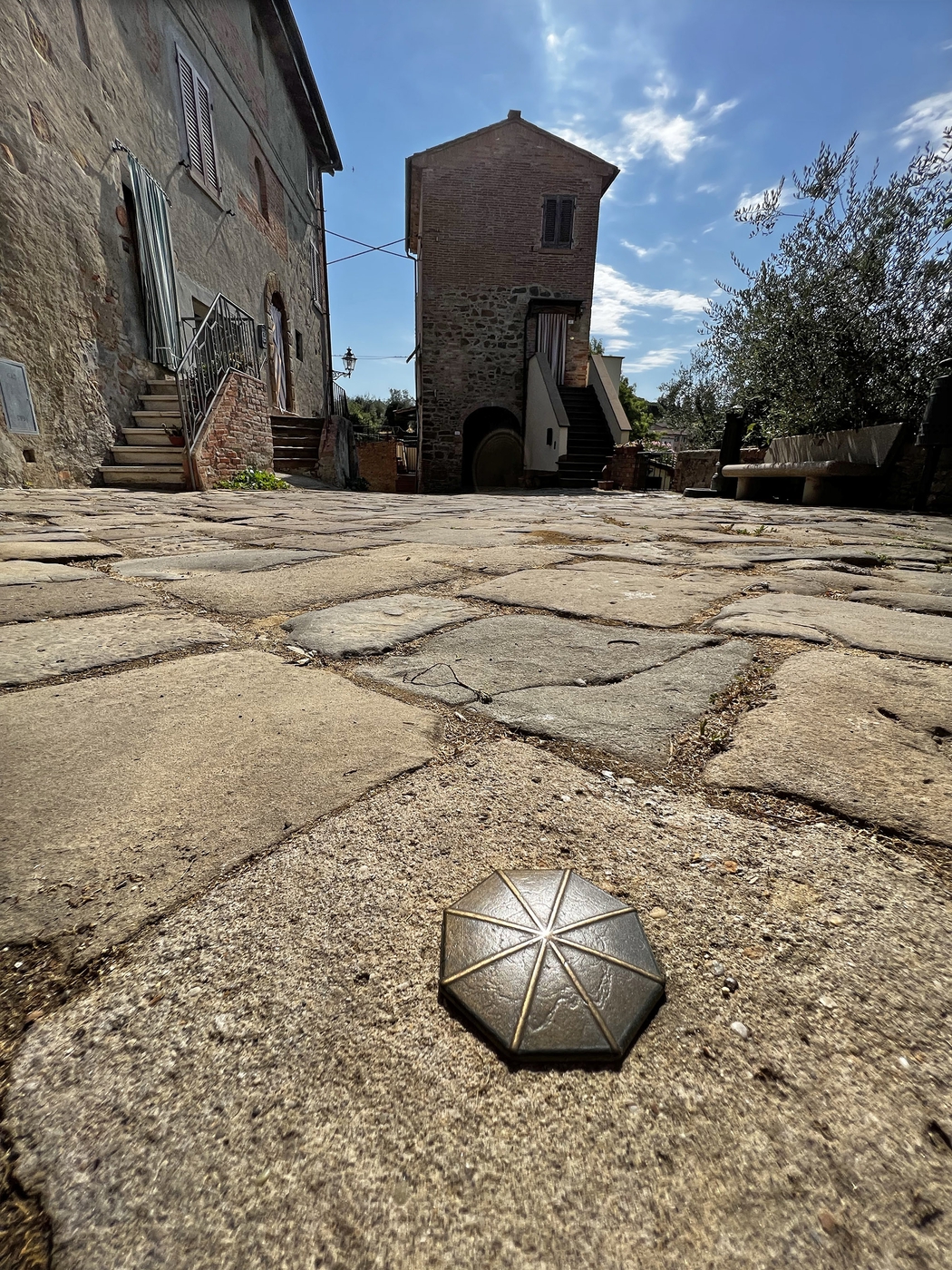
Arte a Peccioli, 1996
The first time that Umberto Cavenago found himself designing a work commissioned by the Municipality of Peccioli dates back to 1996, the year in which, as part of the initiative entitled “Arte a Peccioli”, he created the permanent work Rilievi in the hamlet of Montecchio. The work consists of a series of octagonal bronze elements, placed on the footsteps of the main road of the village and in precise positions obtained from the survey carried out by a team of geologists and geobiologists. Hired by the artist to carry out the study of the terrain, the technicians were tasked with detecting the "Hartmann's net": a system of lines that form a square mesh grid with its points of intersection, called "radiant nodes". As in Feng Shui, ancient geomantic art, geobiolobia also provides the basis for reorganizing the orientations of objects within one's domestic space.
Antonella Soldaini, 2020
The Hartmann net
The relief of the “Hartmann’s net” gave Cavenago the possibility of locating the radiant nodes along the road of the village in order to mark them with the bronze signs embedded in the floor which, thanks to their installation points, have indicated to the inhabitants of the houses, located along via della chiesa di Montecchio, the possible continuation of Hartmann’s net up to the inside of the houses. The knowledge of the orthogonal design of the mesh thanks to the relief made on the road has thus become a suggestion for a possible repositioning, within one’s home, of the furnishings in the different rooms, such as the orientation of one’s bed. The operational strategy adopted by Cavenago in Montecchio aimed to reduce the visibility of the artistic gesture to the minimum in favour of highlighting something already existing and already designed.
Antonella Soldaini, 2020
Sono gli anni in cui l'artista si misura con il concetto di monumento di cui, tramite le sue installazioni, mira a scardinarne gli assiomi e a mettere in evidenza l'obsolescenza e l'inadeguatezza della sua accezione: Leon (1996) ) e il più recente Leopoldo (2019) sono opere che vanno a toccare, in maniera ironica e sottile, i valori, come quelli del patriottismo e dell'eroismo, da sempre associati al concetto di celebrazione nell'opera pubblica. Alla evidente staticità e inamovibilità del monumento su piedistallo Cavenago contrapponeva la suggestione dello spostamento decelebrativo.
Antonella Soldaini, 2020
Il lavoro di Umberto Cavenago (che ha rappresentato l'Italia alla Biennale di San Paolo nel 1996) a Montecchio può passare all'occhio distratto del tutto inosservato. Inutilmente cercherete forme monumentali, architetture evidenti od ostentate epifanie di questa presenza che, invece, è riuscita a inserirsi nel contesto urbano in maniera sottile, quasi cerebrale. Il lavoro è, in effetti, ovunque, ma pressoché invisibile. Il selciato lastricato di Montecchio è costellato di formelle ottagonali in bronzo. La loro disposizione non è casuale, bensì risponde a uno schema determinato. Tale schema forma una griglia, una rete nei cui punti di intersezione sono collocati i Rilievi. Si visualizza così una sorta di campo magnetico, un reticolo invisibile a maglie larghe che imprigiona una silenziosa carica di energia. In quei punti nodali la cittadina accumula le sue forze. La linfa delle storie e dei gesti quotidiani...
Lorenzo Fusi

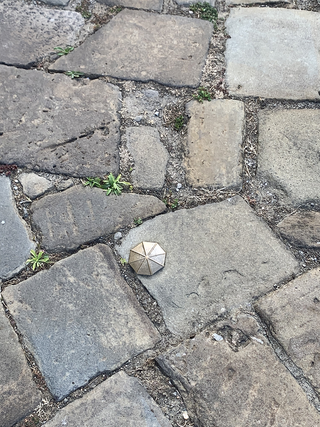
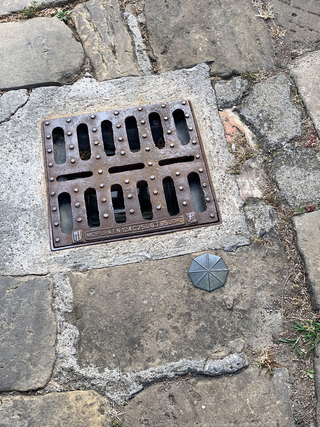
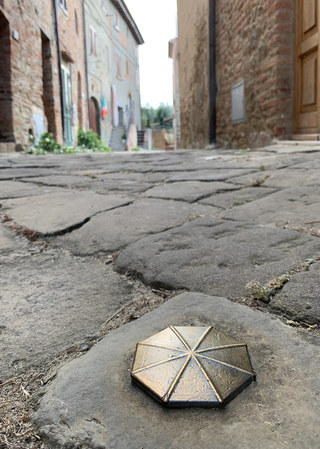


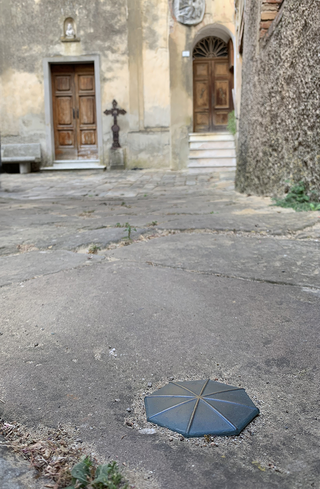
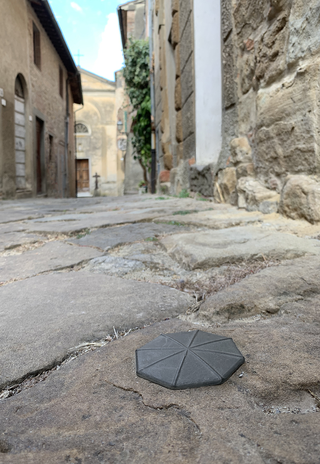
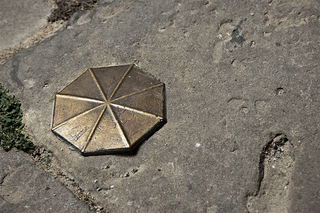
Detail of the signal, 1996
Photo © Davide Cortassa
Via della Chiesa Montecchio, Peccioli

Detail of the signal, 1996
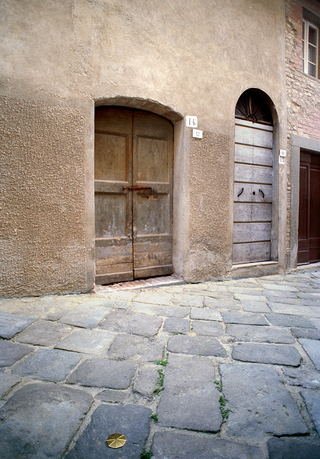
Detail of the signal, 1996
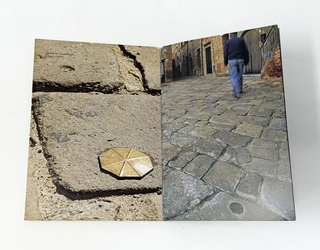
Social
Contatti
umberto@cavenago.info